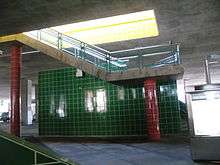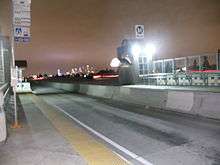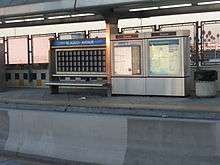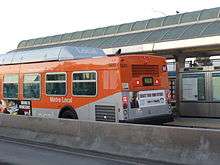Harbor Transitway
| Harbor Transitway | |
|---|---|
|
Metro Silver Line runs on the Harbor Transitway with frequent service. | |
| Overview | |
| System | Combined Transitway Service |
| Operator | Los Angeles County Metropolitan Transportation Authority (LACMTA) |
| Began service | June 1996; December 13, 2009 for Metro Silver Line opening. |
| Routes | |
| Routes | Metro Silver Line (Daily), Metro Express: 442, 460 (Daily), 550, Torrance Transit: 4, Gardena Transit: 1X, OCTA: 701, 721 |
| Locale | Los Angeles, California |
| Start | 37th Street/USC |
| End | Harbor Gateway Transit Center |
| Stations | 6 Metro Silver Line Stations |
The Harbor Transitway is an 11 miles (18 km) shared-use bus corridor (transitway) and high-occupany toll roadway that runs in the median of Interstate 110 (Harbor Freeway) in Southern California. The main bus service operating on the busway is the Metro Silver Line which was introduced on December 13, 2009. The Metro Silver Line bus rapid transit line runs on the Harbor Transitway from Harbor Gateway Transit Center to Downtown Los Angeles and continues to El Monte Bus Station. The line operates daily with frequent service. In addition to Metro Silver Line, other Metro bus and municipal bus routes also operate on the Harbor Transitway. They include Metro Express lines 442, 460 and 550, Torrance Transit line 4, Gardena Transit line 1X and Orange County Transportation Authority lines 701, 721. Metro Express lines 442 and 550 operate only during weekdays peak hours. Metro Line 442 operates peak a.m. northbound only and southbound p.m. only. Torrance Transit line 4, Gardena Transit line 1X, and Orange County Transportation Authority: 701, 721 operate only during weekday peak hours. Metro Express line 460 operates daily along with the Metro Silver Line. Busway bus lines originate from Downtown Los Angeles and El Monte, with final destinations in Disneyland, and Disney California Adventure Park located in Anaheim, Knott's Berry Farm, Artesia, Fullerton, Gardena, Hawthorne, Huntington Beach, San Pedro and Torrance.
In November 2012, the existing high-occupancy vehicle lanes within the Transitway were converted to high-occupancy toll lanes. This is part of the larger Metro ExpressLanes project which added major transportation improvements to the area. A few project-mandated improvements along the Transitway are still being completed.
There are six transit stations on the main section of the Harbor transitway (the section with high-occupancy lanes): 37th Street Station, Slauson Station, Manchester Station, Harbor Freeway/I-105 Station, Rosecrans Station and Harbor Gateway Transit Center (to one side). All of these 6 stations are branded as Metro Silver Line stations. There are a further two stations on the freeway to the south of the transitway: Carson Station and Pacific Coast Highway station. On December 13, Metro Silver Line was extended to serve and terminate in San Pedro. The extension replaced the former Metro Express Line 450. The Silver Line extension follows the exactly routing of Line 450 and terminates at Pacific Ave/21st Street. Along with the replacement of Line 450, a new Metro Silver Line faster version of the line began operation. Dubbed as the Metro Silver Line Express (Line 950X), the line mirrors the current route and stops of Line 450. Not all Metro Silver Line trips end in San Pedro.
History
After 20 years of planning and then construction the combined high-occupancy roadway and transitway was opened in 1998 at a cost of $500 million. Provision was made for the transitway to continue further north from Adams Boulevard/ Flower Street to join the El Monte Busway[1] and construction of the busway included 'ski jumps' just past the on/off ramps at this point.[2]
During the early months of the busway ridership was roughly 3,000 boardings a day. Initial usage was only 5% of the predicted 65,000 and fares were reduced from $3.35 to $1.35 in 2000 to encourage additional usage.[3] Months later Metro officials made several changes to their bus services operating on the Harbor Transitway. During the 1990s Metro staff was studying the possibility of connecting the El Monte Busway with the Harbor Transitway by operating a bus rapid transit line. The project was supported by Metro, but plans were later scrapped because of the lack of funds to operate the bus rapid transit line. The project was later revealed early 2009 by staff. The new project would be called the Dual Hub BRT which was later called the Metro Silver Line. The line got its color from the former color on the El Monte Busway which was silver. The project looked at operating a bus rapid transit on both the El Monte Busway and Harbor Transitway serving Downtown Los Angeles as the halfway point of the line. Future project amenities looked similar to the ones on the Metro Orange Line. A council meeting was held to propose a fare for the Metro Silver Line. The line was originally proposed to operate with a local fare, but was later changed due to the interference of Foothill Transit's Silver Streak line which does not have a local fare. The Metro Silver Line was presented to several council meetings for support from passengers and was approved for implementation.
The Metro Silver Line was introduced on December 13, 2009 using both the Harbor Transitway and the El Monte Busway for a 26-mile service operating mostly on the freeways. Usage on the Harbor Transit way has significantly increased with the implementation of the Metro Silver Line. In particular, ridership has increased between 7th Street/Metro Center Station and the Harbor Freeway Station. Weeks after the Silver Line began service, Metro mailed thousands of brochures of the Metro Silver Line to people living near the I-110 freeway to become aware of the new bus rapid transit line.
Metro ExpressLanes project
The Metro ExpressLanes project began work in 2010 to add improvements to the public transport services and facilities. The security of the Harbor Gateway Transit Center (formerly the Artesia Transit Center) was improved in November 2010 and CCTV was installed. Bike lockers were installed and the existing building was re-purposed as a Sheriff substation.[4][5] Improvements were made to station Lighting Improvements and to the Slauson and Manchester stations.
The high-occupancy lanes between Harbor Gateway Transit Center and Adams Blvd were converted to high-occupancy toll (HOT) lanes. Opened in November 2012, the HOT lanes require Fastrak transponders.
Other changes also include:
- Bus priority is being expanded in Downtown Los Angeles, which will improve performance of the Metro Silver Line.
- New security cameras and digital message boards are being installed at stations on the route.[6]
- Park & Ride facilities are being improved at the Harbor Transitway station.
- More bicycle lockers are to be provided the Harbor Gateway Transit Center.
- A new Bus Maintenance Facility is being constructed in Downtown Los Angeles.
- 59 new Compressed natural gas powered 45-foot buses are to be introduced on the Silver Line, together with 100 new Metro Vanpool vehicles.[6]
Bus services
The Harbor transitway is served by the Metro Silver Line, Metro Express and municipal operators. The Metro Silver Line is the bus service used the most based on ridership on the busway. The busway is primarily used by the Metro Silver Line although there are a number of other express lines, some of which are operated by other transit operators. Each line in the busway has a different fare structure. Metro Silver Line charges $2.50 for a base fare, one way, but Metro Day pass holders do not need to pay an additional charge. Metro and Foothill Transit's Silver 2 Silver program does not apply on the Harbor transitway portion even though the Silver Line operates on both the Harbor and El Monte Busways.
| Metro | Torrance Transit |
|---|---|
| Metro Silver Line Metro Express Lines: 442, 460, & 550. |
Torrance Transit: 4 |
Stations
The transitway is a key component served by the Metro Silver Line and is also served by Metro Express buses, Los Angeles Department of Transportation, Orange County Transportation Authority, Gardena Transit and Torrance Transit buses. Carson and Pacific Coast Highway bus stations are not considered part of the Harbor Busway. These stations were considered part of the busway before the Metro Silver Line was implemented.





| Station | Busway Services | Connections | Station Parking |
|---|---|---|---|
| 37th Street/USC |
|
|
None |
| Slauson |
|
|
151 Spaces |
| Manchester |
|
|
247 Spaces |
| Harbor Freeway |
|
Upper Level:
Street Level:
|
253 Spaces |
| Rosecrans |
|
|
338 Spaces |
| Harbor Gateway Transit Center |
|
980 Spaces | |
| Carson | |
|
140 Spaces |
| Pacific Coast Highway | |
|
244 Spaces |
Usage
Usage of the lanes and bus services has been low, but the Silver Line has helped raise ridership on the Harbor Transitway. The Metro Silver Line began service on December 13, 2009. Ridership is lower than the El Monte Busway, which is also served by the Metro Silver Line. A number of reasons have been identified: The main causes for the low ridership are the premium express fare charged to passengers compared to riders on the Blue Line and Metro Rapid (up to $1 more each way than a trip made on the Rapid or Blue Line), the isolated and noisy freeway environment of the stations, and the inconvenience of accessing the stations (and lack of surrounding buses) around the stations compared to surface level light rail or Rapid service. Ridership began increasing with the advent of the Metro Silver Line. In late June 2011, Metro Silver Line service frequency increased from 30 mins to 15 mins on Weekdays and on Saturdays, service increased from 60 mins to 40 mins. In the February 2012 Metro Express Lanes Program report, ridership on the Silver Line alone on the Harbor Transitway was 3,969.[7] The report revealed that ridership on the Metro Silver Line alone increased 43% from the June 2011 improved frequency of the Metro Silver Line. On June 17, 2012 Metro added the second phase of adding more service to the Silver Line. Weekday peak hour service was added for the Metro Silver Line (an improvement from 10 mins to 4-8 mins). Saturday, Sunday/Holiday service was added for the Silver Line (an improvement from 40 mins to 20 mins on Saturdays and from 60 mins to 30 mins on Sundays/Holidays).
Its main competitors are the Metro Blue Line to Long Beach and the Metro Rapid Line 745, just a block away on Broadway. Ridership on the Transitway is not officially tabulated because service on the Transitway consists of several Metro Express lines, two routes operated by the Orange County Transportation Authority, and services operated by the cities of Gardena, Los Angeles, and Torrance.
Usage of the express lanes by private vehicles has become high enough that speeds have decreased, leading to carpool-only restrictions during peak hours. To compensate, Metro is considering increasing the maximum toll from its current $1.40 per mile cap.[8]
Service history
When the Harbor Transitway opened in 1995 increased service on the existing Harbor Freeway express bus lines and operating each as independent routes. Because most of the buses traveling on the Harbor Freeway served the needs of commuters, service was frequent along the corridors during the weekday peak hours, but infrequent during other times. Ridership was much lower than projected. Planners expected that 65,200 passengers would travel along the Harbor Transitway each day, but after 10 years ridership fell far below those predictions, with the route seeing just 3,000 passengers per weekday in 2004.[9]
In the early 2000s, Metro tried to increase ridership on the Harbor Transitway by branding it as a part of the Metro system and adding it to maps using a bronze color, however, the line was not officially called the Metro Bronze Line.[10]
As part of the establishment of the Silver Line, five Metro Express lines were truncated to terminate at either Harbor Gateway Transit Center or the El Monte station, where passengers would transfer to the Silver Line to continue into Downtown Los Angeles.[11]
Incidents
On February 22, 2012 an incident occurred on the northbound Metro Silver Line platform during the afternoon. A vehicle struck the northbound platform of the Harbor Freeway (LACMTA Station) station served by the Silver Line. The Metro Silver Line bus was not hit by the private truck when it was entering the station.There were 6 passengers who were about aboard the Silver Line bus to Downtown LA as a vehicle struck the platform.[12] The 6 passengers received minor injuries. It took around 2 hours to clear up the scene. During the incident, the Metro Silver Line, Metro Express Lines: 450X and 550 were detoured to stop at Figueroa Street/Harbor FWY station entrance. There has never been an incident on the Harbor Transitway ever since it first opened on June 1998. As a result of the incident, Metro's CEO: Art Leahy asked Metro's safety committee to review the station layout and signage of the Silver Line stations on the Harbor Transitway portion. A report was scheduled within 60 days.[12] The report was complete during April 2012 .[13] Bollards were added during early August 2012 at the station. Bollards were also installed at the 37th Street/USC Metro Silver Line Station as well.
Photo gallery
-

Slauson Silver Line Station freeway pedestrian bridge connected the station and the east side parking lot.
-

The information stands were burly posted during November 2011.
-

The Metro Silver Line has the highest passenger ridership on the Harbor Transitway portion. Metro Express Line 460 places in 2nd place.
-

Metro Express Line 450X to San Pedro arriving at the Harbor Freeway Green/ Silver Lines station, lower level platform.
-

Rosecrans Silver Line Station southbound boarding platform.
-

The Harbor Gateway Transit Center, with a Metro Silver Line bus parked at the station.
-
Metro Express Line 460 leaving Slauson Silver Line Station and is heading to Disneyland.
-
Station security cameras and digital message signs for the Metro Silver Line currently being installed at the station as part of the Metro ExpressLanes project.
-

Rosecrans Silver Line Station, southbound platform with the stop sign.
-
Metro Silver Line soutbound platform at Harbor Freeway Station with bollards placed on the platform edge for passenger safety.
References
- ↑ "Dual Hub High Occupancy Vehicle Transitway" (PDF). MetroMTA.
- ↑ "Google maps satellite view of 'ski jumps'". Google.
- ↑ "Harbor Transitway Has Everything but Riders". Los Angeles Times. 2000-11-20.
The $500-million Harbor Transitway from Wilmington to downtown Los Angeles was supposed to generate 65,000 bus rides a day along the Harbor Freeway. But usage did remain low as 3,000 boardings a day—that the Metropolitan Transportation Authority has slashed the fare by more than half—from $3.35 to $1.35—in hopes of increasing ridership.
- ↑ "LOS ANGELES COUNTY CONGESTION REDUCTION DEMONSTRATION PROGRAM STATUS REPORT" (PDF). 2012-04-18.
- ↑ http://www.metro.net/projects/silverline/
- 1 2 "Metro ExpressLanes". Metro MTA.
- ↑ "Metro ExpressLanes February 2012 Report" (PDF). 2012-03-19.
- ↑ Nelson, Laura J. (March 24, 2015). "MTA's toll-lane project may be a victim of its own success". Los Angeles Times. Retrieved 8 June 2015.
- ↑ Weikel, Dan (December 2, 2014). "A cleaned-up, safer Harbor Transitway puts more commuters on the bus". Los Angeles Times. Retrieved March 9, 2015.
- ↑ (PDF)
- ↑ "SB910 Feb09 public hearing" (PDF). 2009-02-01.
- 1 2 "The Source: Accident on The Harbor Transitway". 2012-02-22.
- ↑ "Harbor Freeway Metro Silver Line Station platform improvements" (PDF). 2012-04-20..
Further reading
- Freeway Bus Station Area Development: Critical Evaluation and Design Guidelines. A Case Study of (I-110) Harbor Transitway Stations
- Highway Oriented Transit System: A Comprehensive Land Use/Transportation Strategy to Improve Transit Service Delivery. A Case Study of (I-110) Harbor Transitway Stations
- Dual Hub High Occupancy Vehicle Transitway A 1993 report by MTA prior to the construction of the transitway
- Harbor Transitway Map and Connections
- Harbor Transitway schedule
External links
- Metro ExpressLanes - includes FasTrak and other toll information for the HOT lanes
